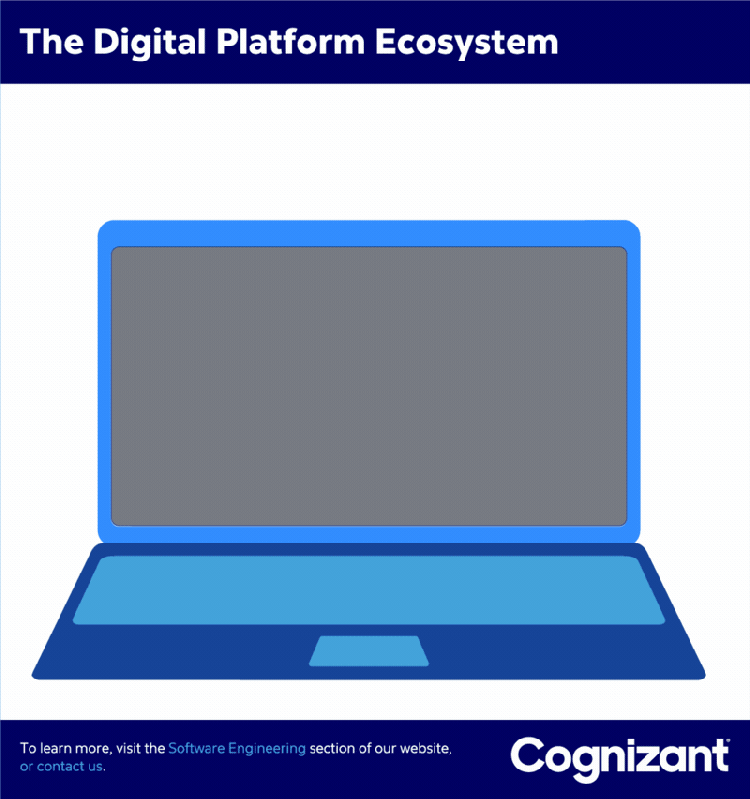
Adopting a platform strategy for growth styles-h2
data-xy-axis-lg:null; data-xy-axis-md:null; data-xy-axis-sm:65% 40%
<p><span class="medium"><br>January 12, 2022</span></p>
Adopting a platform strategy for growth
<p><b>Organizations that deploy open platforms to expand customer capabilities and offer more modern experiences will accelerate growth initiatives, creating strategic advantages in the digital economy.</b></p>
<p>Armed with digital platforms, the world’s most forward-looking organizations are redefining how goods, services and information are exchanged and communities of interest are cultivated to create new digital revenue streams. Platforms have evolved over the last few years. They come in many forms, but all feature a collection of one or more products, components, services<u> </u>and an array of advanced technologies that, when integrated with legacy infrastructure, essentially become the organization’s new operating system, providing a modern, value-rich experience for customers, partners and employees.</p> <p>From service-oriented platforms that underpin the likes of Airbnb and GrubHub to social media and knowledge platforms that keep us all connected and informed, a move to digital platforms can significantly enhance business agility, speed and flexibility as they digitize value streams. Ultimately, they provide a means to effectuate new strategic directions, quickly scale operations and speed products to market to meet ever-advancing customer needs.</p> <p>The benefits and requirements of a platform are many. The best among them:</p> <ul> <li>Establish an ecosystem bringing producers and consumers together through digital channels that create strong, compounding network effects.<br> <br> </li> <li>Integrate with heritage systems and digitize business processes and capabilities, unlocking greater value and delivering users a <a href="https://digitally.cognizant.com/how-an-experience-is-delivered-is-the-experience-codex6839" target="_blank" rel="noopener noreferrer">modern experience</a>.<br> <br> </li> <li>Require the support of a solid software engineering foundation and deep product-management skills to deploy enabling technologies and new operational paradigms.<br> </li> </ul> <p>As management teams explore how this approach can unleash new value propositions and operating models to attain ambitious goals, they must first understand what lies ahead. Creating a platform requires significant stakeholder and technology foresight. It involves integrating a vast array of technologies, such as microservices-based, service-oriented architectures; cloud technologies; Internet of Things (IoT) connectivity; data analytics; artificial intelligence (AI); and integration of application programming interfaces (APIs) with legacy systems. Platform building also leans heavily on data science, design thinking, and deep industry and process knowledge to unite physical and virtual activities across value streams.</p> <p>Before venturing forth, assess the organization’s technological aptitude, readiness and maturity, and address any outdated practices. Ensure an ability to sustain the platform and related products long-term through capabilities training in Agile/DevOps-based lifecycle approaches, user experience design, product-centricity, design/coding principles, automation and the use of containers.</p> <p>Building platforms, however, isn’t as daunting as it sounds. Based on our experience, here are seven key considerations to enhance and accelerate the journey to becoming a platform-based digital business:</p> <h5><i><b>1.</b> </i> Focus on strategic intent and secure executive sponsorship and investment</h5> <p>An organization’s market-focused goals and strategy should dictate the need for a platform approach, whether the aim is to expand into new regions or markets, launch new business models to market products and services, or offer radically new digital ways of doing business.<br> </p> <p>Exploring and pursuing a platform approach requires concerted commitment that must extend beyond the IT function. Form a CxO-level steering committee with representatives from across the business. Include leaders of functions that fall within the program’s reach, as impacts will be felt across ecosystems as value streams are digitized to connect key stakeholders, such as employees, vendors, partners and customers.</p> <p>With an executive sponsor at the helm and as the discovery process progresses, this team will draft the roadmap and secure required budgets to invest in the needed tools, technologies and approaches. The roadmap should include an action plan that supports needed workforce enablement, process redesign and cultural alignment.</p>

#
<h5><i><br> </i><b><i>2</i>.</b> Align with the application modernization strategy</h5> <p>Constructing a platform-centric approach doesn’t resemble a quick “lift-and-shift” migration or enhancements to specific applications. When embarking on building a platform, align the application modernization process accordingly.<br> </p> <p>Assess legacy IT applications that will be included and categorize them using application portfolio rationalization (APR) techniques such as 6R analysis. This exercise will help determine how best to onboard each application to cloud infrastructure and where remediation is required. Focus on implementing a capability-led application transition. Start by value-stream mapping each business capability. Then, identify where newly developed (greenfield) products are viable and required to optimize processes along the value stream.</p> <h5><i><b>3.</b> </i> Adopt customer-centricity with a product mindset<span style="color: rgb(0,0,0);"><b></b></span></h5> <p>Software applications produced by IT teams need to meet ever-rising user expectations by performing on par with commercial code across all dimensions, spanning availability, usability, scalability, fault-tolerance, privacy and security. Focus on enriching the user experience and delivering quality products with maintainability, speed-to-value and a high return on investment.</p> <p>Apply <a href="https://www.interaction-design.org/literature/topics/design-thinking" target="_blank" rel="noopener noreferrer">design thinking</a> to understand and <a href="https://digitally.cognizant.com/exceptional-cx-consistently-codex6671" target="_blank" rel="noopener noreferrer">engineer customer experiences</a>. Collect metrics that matter and empower frontline workers to capture the voice of the customer to fuel continuous improvement.<br> </p> <p>Embedding a product-centric mindset to software engineering requires the IT organization to take a <a href="/content/dam/connectedassets/cognizant-global-marketing/marketing-channels/cognizant-dotcom/en_us/insights/documents/17-must-do-s-to-create-a-product-centric-it-organization-codex4674.pdf" target="_blank" rel="noopener noreferrer">systematic approach</a>. Instate techniques such as continuous collaboration, customer journey mapping, data analytics and customer insight.</p> <p>In this vein, a leading US life insurance company enhanced its customer experience as we applied these practices to develop a new IT platform that required migrating legacy technology to the cloud and consolidating underperforming portals into a single web experience.</p> <h5><i><b>4.</b></i> Embrace modern technologies</h5> <p>A platform strategy extends well beyond migrating legacy applications to cloud ecosystems; it requires new technologies to power advanced capabilities and connectivity. Incorporate big data, IoT, AI, machine learning and blockchain to support new strategic approaches such as multichannel or omnichannel commerce.</p> <p>Moreover, identify where productivity accelerators, such as process automation, can improve consistency and reduce manual work. Implement a tools-based approach for better work execution and communications across teams, improving efficiency and traceability. Seek more systematic use of high-quality, reusable software components (code) and frameworks.</p> <p>For example, we applied process automation as part of a <a href="/content/dam/connectedassets/cognizant-global-marketing/marketing-channels/cognizant-dotcom/en_us/case-studies/documents/technology-transformation-spurs-turnaround-codex3879.pdf" target="_blank" rel="noopener noreferrer">new claims processing platform</a> for a large health plan that brought claims inventory to near-zero levels and saved $900 million in expenses over seven years.</p> <h5><i><b>5.</b> </i> Ensure continuous delivery of quality software product releases</h5> <p>Seek to improve application development practices and team capabilities before moving forward with new platform-related projects. Assess the current maturity levels of existing Agile and DevOps practices to identify any gaps. Consider investing in <a href="/content/dam/connectedassets/cognizant-global-marketing/marketing-channels/cognizant-dotcom/en_us/case-studies/documents/modern-digital-foundation-empowers-freight-leader-to-adapt-to-changing-market-conditions-codex5479.pdf" target="_blank" rel="noopener noreferrer">Agile coaching</a>, where needed, to help team members unlearn any old ways of working and adopt new approaches. Establish collaborative governance to oversee Agile-DevOps progress and set release milestones, aspiring to higher levels of such practices along the journey.</p> <p>Adopt a wave-based development approach and apply continuous delivery practices to each wave. A continuous delivery approach helps speed releases of minimum viable products (MVPs) as well as subsequent production releases. This will also contribute to lower costs and higher code quality.</p> <h5><i><b>6.</b> </i> Enable a cultural shift and business alignment</h5> <p>IT organizations with traditional software engineering practices and a charter to simply “keep the light on” often encounter culture clashes or compatibility issues when pursuing platform projects. To avoid potential roadblocks:</p> <ul> <li>Nurture an open culture that encourages experimentation and fail-fast-fail-early mindsets<br> <br> </li> <li>Establish a flexible funding model to help speed product and platform development<br> <br> </li> <li>Provide continuous feedback, rewards, recognition and performance enhancements rather than standard annual reviews</li> </ul> <p>Engage a variety of learning methods, from online and instructor-led to hands-on, case-study-based teachings through experiments and exploration. Allow team members to experience how things actually work.</p> <p>Create synergies across IT and the business to understand priorities, define the problem space and create solutions iteratively. Focus collaborations on problem solving and “solution-ing,” to promote a <a href="https://www.devopsdigest.com/bizdevops-solving-the-digital-dilemma-for-transformational-success" target="_blank" rel="noopener noreferrer">BizDevOps</a> culture across the organization and instate an effective feedback loop and value alignment.</p> <h5><b><i>7</i>.<i> </i> </b>Apply multitiered governance<b><span style="color: rgb(0,0,0);"></span></b></h5> <p>Orchestrate communication and collaboration across product and platform teams to help manage dependencies, reduce conflicts and avoid delays. Governance of product and platform teams requires a multitiered approach, including:</p> <ul> <li><b>Platform governance:</b> Product managers, product architects and the platform leadership team should meet monthly or fortnightly based on release frequency, work complexity, ongoing changes and business criticality. Review and discuss the short-medium-long-term platform roadmaps and related product dependencies, end-user feedback and problem areas that need to be resolved.<br> <br> <b></b></li> <li><b>Product governance: </b>This team covers product-specific enhancements and identifies fixes that require changes at the product level. For instance, before adding a new field in a product screen, ensure corresponding messages that interface with downstream systems and back-end data stores can handle the new field. Assess how any changes might affect the platform and dependent products or external interfaces, and ensure adequate testing to avoid unexpected issues and downtime.<br> <br> </li> <li><b>Talent governance: </b>Manage talent demands, transitions and transfers across the program to mitigate risk, backfill attrition and promote knowledge sharing. Guard against impacts on the platform schedule and tend to team morale.</li> </ul> <p>After launching the new platform, conduct ongoing research into market and competitive trends to identify needed enhancements. Be mindful of regulation changes, new security requirements and any compliance needs.</p> <p><i>This article was written by Raja Bavani, an AVP in Cognizant’s Digital Engineering Practice.</i></p> <p><i>To learn more, visit the </i><a href="/content/cognizant-dot-com/us/en/services/software-engineering-services.html" target="_blank" rel="noopener noreferrer"><i>Software Engineering</i></a><i> section of our website, or </i><a href="/content/cognizant-dot-com/us/en/about-cognizant/contact-us.html" target="_blank" rel="noopener noreferrer"><i>contact us</i></a><i>.</i></p>
<p>We’re here to offer you practical and unique solutions to today’s most pressing technology challenges. Across industries and markets, get inspired today for success tomorrow.</p>
